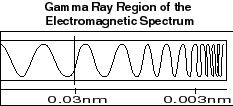CIDPUSA.org | ||
Gamma-rays
Gamma-rays have the smallest wavelengths and the most energy of any other wave in the electromagnetic spectrum. These waves are generated by radioactive atoms and in nuclear explosions. Gamma-rays can kill living cells, a fact which medicine uses to its advantage, using gamma-rays to kill cancerous cells. Gamma-rays travel to us across vast distances of the universe, only to be absorbed by the Earth's atmosphere. Different wavelengths of light penetrate the Earth's atmosphere to different depths. Instruments aboard high-altitude balloons and satellites like the Compton Observatory provide our only view of the gamma-ray sky. Welcome Gamma Rays Gamma-rays are the most energetic form of light and are produced by the hottest regions of the universe. They are also produced by such violent events as supernova explosions or the destruction of atoms, and by less dramatic events, such as the decay of radioactive material in space. Things like supernova explosions (the way massive stars die), neutron stars and pulsars, and black holes are all sources of celestial gamma-rays. How do we "see" using gamma-ray light?Gamma-ray astronomy did not develop until it was possible to get our detectors above all or most of the atmosphere, using balloons or spacecraft. The first gamma-ray telescope, carried into orbit on the Explorer XI satellite in 1961, picked up fewer than 100 cosmic gamma-ray photons! Unlike optical light and X-rays, gamma rays cannot be captured and reflected in mirrors. The high-energy photons would pass right through such a device. Gamma-ray telescopes use a process called Compton scattering, where a gamma-ray strikes an electron and loses energy, similar to a cue ball striking an eight ball. .jpg) This image shows the CGRO satellite being deployed from the Space Shuttle orbiter. This picture was taken from an orbiter
window. The two round protrusions are one of CGRO's instruments, called "EGRET". This image shows the CGRO satellite being deployed from the Space Shuttle orbiter. This picture was taken from an orbiter
window. The two round protrusions are one of CGRO's instruments, called "EGRET".
continued to next page what gamma rays show us | ||